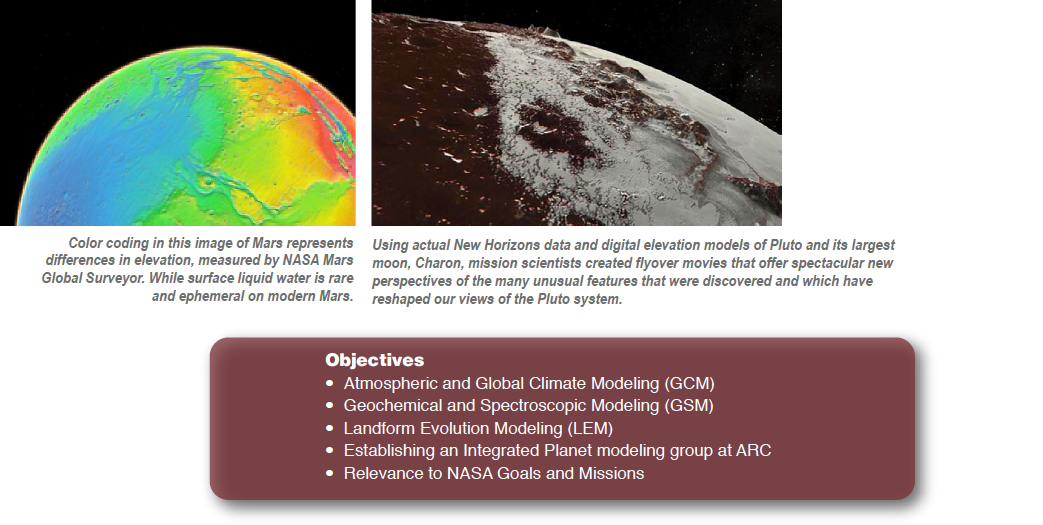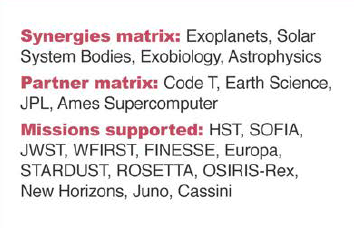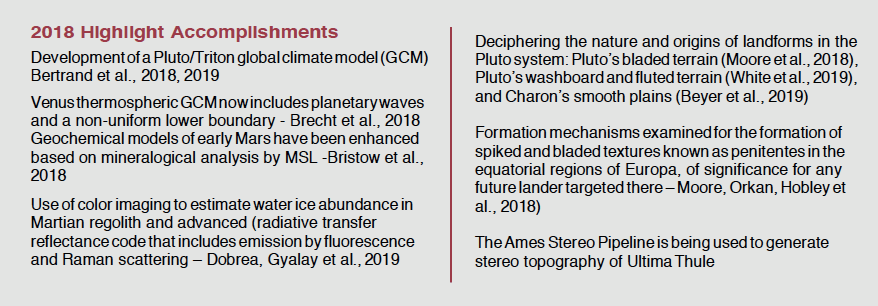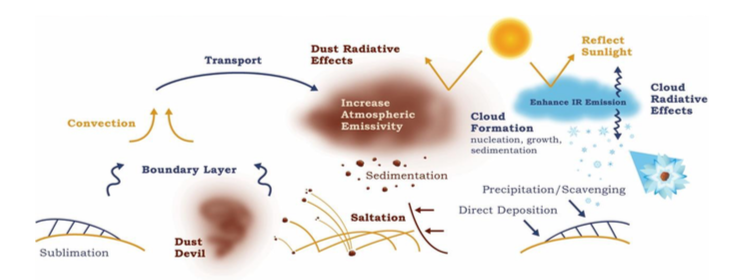Core Capability 1 – Planet Modeling
Planet Modeling Highlights
The goal of performing computer simulations of natural phenomena in a planetary environment is to define what processes and conditions are necessary for such phenomena to take place, based on existing remote sensing and in situ observations. How accurately the observations can be replicated within the simulation is dependent on the extent to which the construction of the model is grounded in the relevant physics and chemistry, and to which the physical parameters in the simulation are constrained.
The last few decades have witnessed great advancement in the complexity and spatial resolution attained by models that simulate atmospheric, landform, and geochemical processes. While this field is constantly evolving, it is presently directly and centrally applicable to a range of strategic NASA goals and provides essential guidance in the development of upcoming planetary missions and associated technologies.
The synergistic relationship that exists between atmospheric, landform, and geochemical modeling strengthens each of them beyond what any one is capable of alone. Computer modeling of these processes fundamentally contributes to planetary research at NASA ARC and to NASA’s science vision, in general.
Objective 1.1 – Atmospheric and Global Climate Modeling (GCM)
The primary goals of Planetary Atmospheric and Global Climate Modeling (GCM), located at Ames, are studies to isolate, quantify, and understand physical processes (Figure 1.1) that control current and past (i.e., paleo-) atmospheric thermal and dynamical states of solid-surface bodies with atmospheres in our solar system, and to investigate how these processes have controlled the evolution of atmospheres/climates over time. Additionally, these processes are compared from one solid-surface planetary body to another. Key to this enterprise is utilizing scientific expertise in atmosphere/climate studies, the vast experience within the Agency Mars Climate Modeling Center (MCMC), and the local high-end computing (HEC) capabilities established at NASA ARC. Modern geophysical fluid dynamics (GFD) global computational frameworks will be leveraged at high spatial resolution that are highly scalable on massively-parallel HEC architectures. The investigations will include examining the interaction between planetary atmospheres, their surfaces, and the solar environment, and how the evolution of planetary atmospheres can be conducive for habitability.
Along with spacecraft measurements, these goals are most often accomplished using state-of-the-art numerical models. To date, the primary focus within the Planetary Systems Branch and the Space Science and Astrobiology Division have been toward terrestrial-like (i.e., solid surface) planets with significant atmospheres in our solar system as well as the moon’s exo-sphere. Over the next five years, the investigations will be broadened to cover newly discovered exoplanetary atmospheres and their climates.
Objective 1.2 – Geochemical and Spectroscopic Modeling (GSM)
The primary goal of geochemical and spectroscopic modeling (GSM) studies at ARC is to reconstruct ancient physicochemical conditions in near-surface environments to identify the characteristics and distribution (both temporally and spatially) of potentially habitable solar system environments and assess their astrobiological potential. This approach utilizes remote- and ground-based observations of the chemistry, mineralogy and geological context of planetary materials and surfaces, and is a crucial activity in the search for evidence of life beyond Earth. The constraints obtained from GSM studies provide important inputs and conditions and are thus synergistic with the LEM and GCM efforts described in separate objectives within this Planet Modeling subsection of the Strategic Goal.
The quality of predictions and output of geochemical models depend on three key aspects:
- reliable input parameters (observations),
- use of appropriate thermodynamic and kinetic datasets, and
- appropriate scaling of model complexity based on the information at hand and the problem being addressed.
The approach to enhancing ARC GSM capabilities and supporting the goal of assessing astrobiological potential in the solar system promotes all three of these aspects, involving development of space-flight instrumentation designed to catalogue mineralogy and geochemistry; curation of mineralogical standards and astrobiologically relevant analogues and materials; and establishment of a database of these materials with detailed mineralogical and geochemical information and supporting thermodynamic and kinetic information. There exists here a strong connection with the Analog Research capability.
Objective 1.3 – Landform Evolution Modeling (LEM)
The goal of Landform Evolution Modeling (LEM) is to simulate the evolution of planetary landscapes through multiple, concurrent, interacting geological processes (e.g., wind, rain, impact cratering, weathering, etc.) acting either simultaneously and/or sequentially at different rates upon the terrain (Figure 1.2). The landscapes of worlds with atmospheres are a record of their climate evolution. This makes LEM a very powerful tool for planetary evolution investigations, as simulation results can be quantitatively compared to observations provided by NASA missions in order to constrain and quantify
- The parameter space of an environment in question, such as the compositions and abundances of materials composing the landscape, and atmospheric properties that are necessary to accommodate certain landform evolution processes (e.g., rainfall and runoff, sublimation and condensation of volatiles, etc.);
- The initial geological and environmental conditions, in particular, whether a certain initial topography and subsurface structure (e.g., layered, fractured) is necessary to evolve a landscape into its present appearance; and
- The identities of the major landform evolving processes that have acted upon the landscape to shape it to its present state, including the rates and episodes at which the processes have been operating.

LEM can determine the timescales over which the climatic conditions responsible for these processes have operated, and whether they are episodic, progressive, or cyclical, or some combination. As NASA re-emphasizes the Moon as a target, many opportunities for the modeling of the Moon’s topography at meter scales in the circum-polar region have arisen. Application of state-of-the-art shape-from-shading techniques will prove to be mission-enabling for missions such as Resource Prospector.
The value of LEM relies very much on topography modeling (i.e., generation of digital elevation models for a planetary surface using spacecraft data), as it essentially provides the observations by which the products of LEM are judged, in order to identify what parameter space, initial conditions, and process suite produces a final topography that matches what is seen in reality. Ames is where the Stereo Pipeline (NASA’s open source automated stereogrammetry software) was created and where the expertise resides within the active planetary topography community.
Objective 1.4 – Establishing an Integrated Planet Modeling Group at Ames
An integrated NASA ARC Planet Modeling effort will provide to NASA and the community a unique and interdisciplinary team with a broad range of expertise not found elsewhere. By fostering close collaboration between separate areas of modeling within ARC and across the Agency, an integrated planet atmosphere and surface modeling group can directly influence the design and priorities of future NASA planetary missions. This core competency will sustain, improve, and create the next generation of NASA science planet models and provide a resource for Agency and community scientists to call upon the abilities and models facilitating the path toward new scientific discovery.
Objective 1.5 – Relevance to NASA Goals and Missions
Planet modeling is a fundamental step towards “Understanding the Sun, Earth, Solar System, and Universe” in Strategic Objective 1.1 of the 2018 NASA Strategic Plan, in particular, Strategic Goal 1 “ExpandHuman Knowledge Through New Scientific Discoveries” for the NASA Ames Research Center, pp. 46–47).
Our objectives also address ARC strategic goals 1 and 2 in the 2018 NASA Strategic Plan, specifically to “expand human knowledge through new scientific discoveries” based on the “basic and applied research” that we conduct in “astrobiology and the planetary sciences”, and to “extend continuous human presence deeper into space and to the Moon for sustainable long-term utilization” based on our “work in life, lunar, and planetary sciences”. Our objectives will address the requested capabilities in the level 3 Science Modeling goal (11.2.4) as described in the 2015 NASA Technology Roadmap for Modeling, Simulation, Information Technology, and Processing, in that we will “sustain, improve, and create the next generation of NASA science models that will facilitate the path toward new scientific discovery in… Planetary Science”.
Planet modeling is directly relevant to the Space and Earth Science and Astrobiology and Life Science Core Areas of Expertise of ARC. In the search for life in the universe, our model results will identify the characteristics and the distribution of potentially habitable environments on Mars and other solar system bodies, and guide the hunt for organic remnants of potential inhabitants. As such, our modeling directly pertains to the topic in the 2015 NASA Astrobiology Strategy of “identifying, exploring, and characterizing environments for habitability and biosignatures”, in particular with respect to determining the astrobiological potential of ancient Mars. Planet modeling constrains the probable range of conditions and materials (surface and atmospheric) that prevail at target sites based on existing remote sensing and in situ observations, and so provides guidance for future missions by allowing instrumentation and observation planning to be designed accordingly, e.g. Mars 2020 rover / Next Mars Orbiter (GCM, LEM, GSM) & Europa Clipper (LEM, GSM). In anticipation of forthcoming NASA-related lunar missions (e.g. Commercial Lunar Payload Services), LEM and GSM will yield results on the transport and stability of lunar volatiles that are not only highly relevant to lunar science, but also to in situ resource utilization and associated exploration.































